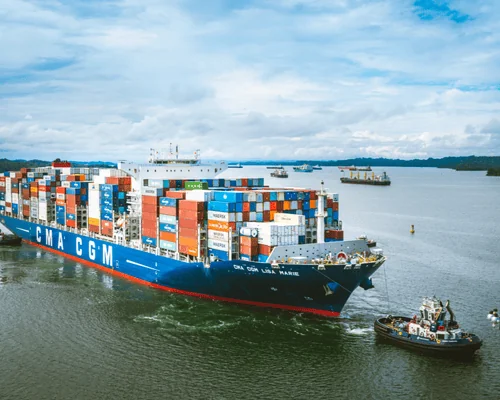
Cross-Border Shipping
Cross border shipping is made easy with FreightCenter. Call now to get a quote.
What Is Cross-Border Shipping?
Cross-border shipping involves the movement of goods across international borders, enabling trade between nations. It encompasses various logistical processes such as customs clearance, documentation, and transportation to ensure the smooth delivery of products.
Goods can be transported through different means like air freight, ocean freight, road transport, or rail transport, depending on factors such as distance and the type of items being shipped.
Successful cross-border shipping requires adherence to the customs regulations and trade laws of both the exporting and importing countries, which includes managing documentation, tariffs, taxes, duties, and import/export restrictions.
Efficient cross-border shipping plays a crucial role in global trade and e-commerce by allowing businesses to reach new markets, expand their customer base, and offer a broader range of products and services. However, it also presents challenges such as complex logistics, regulatory compliance, and the potential for delays or disruptions.
Thousands of businesses trust FreightCenter to move their freight faster, smarter, and cheaper! From unbeatable rates to top-notch service, our customers are raving about their shipping success.
See why they keep coming back!
Award-Winning Service, Trusted by Shippers Everywhere!
- 2021, 2017 & 2016 Food Logistics’ Top Green Providers
- 2021 & 2018 Supply & Demand Chain Executives’ Pros to Know: Matthew Brosious
- 2020 & 2019 Top Food Logistics’ 3PL & Cold Storage Provider Award
- 2020 & 2019 Business Observer’s Top 500 Companies on the Gulf Coast
- 2020 & 2017 SmartWay® Transport Partner
- 2020 & 2017 Food Logistics’ Champions: Rock Stars of the Supply Chain
- 2020 Best of Palm Harbor Awards for Local Businesses
- 2017 Green Supply Chain Award from Supply & Demand Chain Executive
- 2017 Tampa Bay Business Journal Heroes at Work
- 2016, 2015, & 2012 Food Logistics Top 100 Software and Technology Providers
- 2013 Tampa Bay Business 100 by Tampa Bay Business Journal
- 2013 Top 100 Great Supply Chain Partners by SupplyChainBrain
- 2012 TIA Samaritan Award Honorable Mention
- 2012, 2011 & 2010 TBBJ Fast 50 Recipient
- 2013, 2011, & 2010 Diversity Business Top Businesses
Cross-Border Shipping Made Easy With FreightCenter
- Competence: FreightCenter’s team of experts understands the complexities of cross-border shipping, including all regulations, documentation, and modes of transport.
- Carrier Network: FreightCenter partners with a vast network of carriers specializing in cross-border shipping, ensuring access and reliable services.
- Documentation: FreightCenter can assist with preparing and managing shipping documents required for cross-border shipping.
- Cost-Effective: FreightCenter can help find the most cost-effective options for your cross-border shipping needs.
How To Ship Cross-Border
– Research and Planning: Understand the regulations and requirements of both importing and exporting countries. FreightCenter can help you find the best carriers for your shipment.
– Paperwork: Prepare all necessary shipping documents to ensure they are accurate and comply with customs regulations.
– Customs Broker Services: We partner with Willson International Customs Brokerage. They will assist you with the requirements and documentation needed for a smooth clearance of goods.
– Shipping Method: Choose the right shipping method based on the commodity type, destination, budget, and timeline.
– Packaging: Ensure your goods are properly and securely packed with the appropriate materials and methods to withstand international shipping.
– Insurance: Consider purchasing shipping insurance to protect against any loss or damage during transit.

Cross-Border Shipping to Canada
Freight shipping in Canada offers a range of benefits and services to ensure the efficient transportation of goods across the country. With FreightCenter, you can take advantage of the following:
– Cost Comparison: Easily compare costs from multiple trusted cross-border trucking companies, allowing you to find the most competitive rates for your shipments.
– Vetted Carriers: Work with carriers that have been thoroughly vetted and insured, which will provide you with peace of mind and reliable service.
– Customs Broker Services: Access professional customs broker services to navigate the complexities of cross-border shipping, ensuring compliance with regulations and smooth clearance of goods.
– Online Tracking and Tracing: You can track and trace your shipments online with automatic carrier updates. This feature allows you to stay informed about the status of your shipments at all times.
– Convenient Booking and Quoting: Easily manage all your bookings and quotes through your personalized MyFreightCenter homepage, providing a streamlined and efficient experience.
Required Documents:
– Bill of Lading: This document is a contract between the shipper and the carriers, outlining the terms and conditions of transportation. It also includes information about the shipment’s origin, destination, and content.
– Canada Customs Invoice: This document details the goods being shipped, their description, quantity, value, and other relevant information.
– Packing List: This document helps customs officials verify the content of the shipment.
– Customs Declaration: This document is issued by customs authorities to assess duties and taxes and ensure compliance with import/export regulations.
– Certificate of Origin: This document certifies the country of origin of the goods. It may be required to determine eligibility for preferential trade agreements or to comply with specific import regulations.
Download your cross border Canada shipment forms.

Cross-Border Shipping to Mexico
Cross-border shipping to Mexico is a significant aspect of trade between Mexico and its neighboring countries, particularly the United States. Here is what you need to know:
– Research and Documentation: Know the rules and paperwork needed to bring goods into Mexico. This means figuring out how goods are classified for taxes, getting any necessary permits, and getting all the right documents ready for shipping.
– Select a Freight Carrier: Choosing a reliable carrier with experience in cross-border shipping to Mexico is crucial. Luckily, FreightCenter can help you find expert carriers, arrange customs clearance, arrange transportation, and navigate regulatory requirements.
– Packaging and Labeling: Make sure your items are packed and labeled correctly, following the rules in Mexico. This might mean giving precise descriptions of your products, labeling everything in Spanish, and meeting packaging guidelines.
– Transportation Method: Choose the right way to transport your shipment, whether by truck, train, plane, or ship. Consider how much it costs, how long it takes to get there, and what kind of stuff you’re shipping when you decide how to send it.
FreightCenter offers various cross-border shipping solutions.
LTL, which stands for "Less-Than-Truckload," is a way of shipping smaller amounts of freight in the transportation industry. Instead of needing a whole truck for just a few items, LTL carriers combine shipments from different customers onto one truck. This sharing helps cut down on costs for everyone involved.
FTL, or Full Truckload, is a method of moving goods using a truck to transport a large amount of cargo from one place to another. Unlike LTL (Less-Than-Truckload) shipping, where multiple shipments share one truck, FTL dedicates the entire truck to just one shipment. This shipment usually belongs to one customer or sender.
Ocean freight shipping is often the best choice when you need to move cargo globally at a good price. But it can take a while to ship things overseas. That's where we come in. We can manage all your sea freight needs, making it easier for you. With our experience in transportation, we provide complete solutions for your shipping needs. Our international ocean shipping services cover everything and promise to cut down your shipping costs for all container freight.
Air freight moves goods using either a charter or a commercial air carrier. These shipments go from airports used for both passenger and commercial flights to any airport worldwide.
Specialized freight involves transporting goods that need special handling, equipment, or know-how because of their unique features, size, shape, or sensitivity. It requires customized solutions to make sure the cargo gets to its destination safely and securely, meeting its specific needs.
Heavy haul shipping, sometimes called heavy equipment transportation, is all about moving really big or heavy stuff that regular shipping methods can't handle.
Expedited shipping is a special service for freight that needs to get to its destination faster than usual. When you choose expedited shipping, carriers make it a priority, so your shipment has fewer stops and delays along the way.
Refrigerated freight is cargo that needs special temperature control while it's being shipped. That's where refrigerated trucks, also called reefer trucks, come in. These trucks have their own cooling systems inside to keep the cargo cold. This ensures your freight gets to where it's going fresh and in good condition.


Tips For Successful Cross-Border Freight Shipping
- Know the Regulations: Get familiar with the customs regulations and requirements of the countries.
- Have the Accurate Documentation: Ensure that your shipping papers are correct, filled out fully, and follow the rules of customs.
- Choose the Right Carrier: FreightCenter can help you select a reliable carrier while considering factors such as shipping routes, transit times, and service reliability.
- Track Shipment: Use tracking services to monitor the status of your shipments in transit. FreightCenter allows you to track your shipment with their user-friendly website.
FAQ For Cross-Border Shipping:
Q. What is cross-border shipping?
Cross-border shipping involves moving goods from one country to another via truck, ship, or plane. Essential for international trade, it enables businesses to access foreign markets, increasing the potential for customer growth, brand expansion, and revenue. Compliance with various customs regulations is a key component of successful cross-border shipping.
Q. How to do cross-border shipping?
For a smooth cross-border shipping experience, follow these steps: Begin by familiarizing yourself with the import rules and regulations of the destination country. Next, choose a reputable international courier with a track record in cross-border logistics. Then, ensure you have accurate customs documentation to prevent delays and ensure correct duty payments. Consider shipping solutions with tracking features to monitor parcels from start to finish. Lastly, think about your packaging, which should be able to withstand long transit times and varying conditions.
Q. Do I need to pay duties and taxes on shipments to Canada or Mexico?
Yes, most cross-border shipments are subject to duties and taxes.
Q. What is the cheapest way to ship to Canada?
FreightCenter works with a vast option of expert carriers and can help you find a cost-effective option for your shipment.
Q. How long does shipping to Mexico usually take?
Shipping times can vary based on distance or customs processing delays.
Advantages of Using FreightCenter

Customer Support
FreightCenter can assist with any questions or issues that may arise during the shipping process. This is particularly valuable for cross-border shipments, where communication and coordination may be more complex.

Carrier Network
FreightCenter works with many carriers experienced in cross-border shipping. They can offer many shipping solutions, including faster services or special equipment, if needed.

Technology
FreightCenter offers online booking platforms, tracking systems, and logistics management software to improve visibility and transparency throughout the shipping process.


